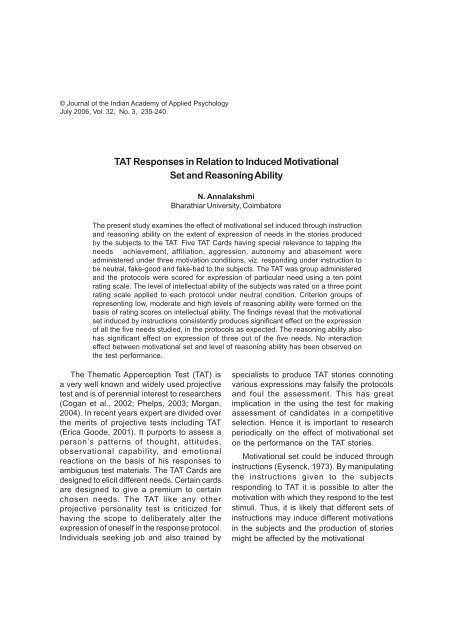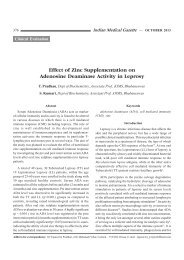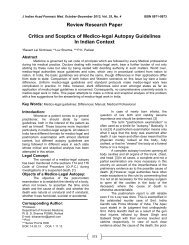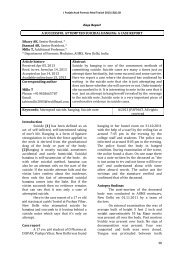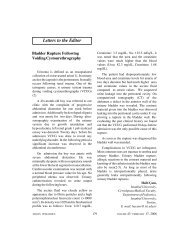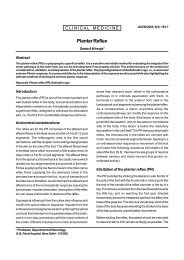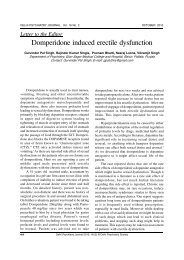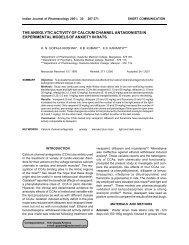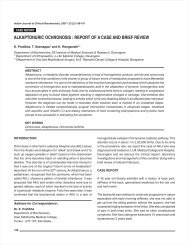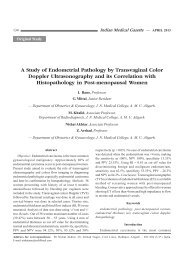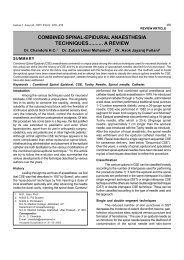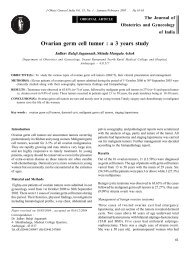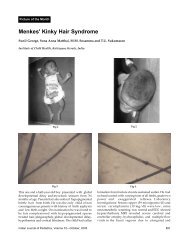TAT Responses in Relation to Induced Motivational Set ... - medIND
TAT Responses in Relation to Induced Motivational Set ... - medIND
TAT Responses in Relation to Induced Motivational Set ... - medIND
Create successful ePaper yourself
Turn your PDF publications into a flip-book with our unique Google optimized e-Paper software.
© Journal of the Indian Academy of Applied Psychology<br />
July 2006, Vol. 32, No. 3, 235-240.<br />
<strong>TAT</strong> <strong>Responses</strong> <strong>in</strong> <strong>Relation</strong> <strong>to</strong> <strong>Induced</strong> <strong>Motivational</strong><br />
<strong>Set</strong> and Reason<strong>in</strong>g Ability<br />
N. Annalakshmi<br />
Bharathiar University, Coimba<strong>to</strong>re<br />
The present study exam<strong>in</strong>es the effect of motivational set <strong>in</strong>duced through <strong>in</strong>struction<br />
and reason<strong>in</strong>g ability on the extent of expression of needs <strong>in</strong> the s<strong>to</strong>ries produced<br />
by the subjects <strong>to</strong> the <strong>TAT</strong>. Five <strong>TAT</strong> Cards hav<strong>in</strong>g special relevance <strong>to</strong> tapp<strong>in</strong>g the<br />
needs achievement, affiliation, aggression, au<strong>to</strong>nomy and abasement were<br />
adm<strong>in</strong>istered under three motivation conditions, viz. respond<strong>in</strong>g under <strong>in</strong>struction <strong>to</strong><br />
be neutral, fake-good and fake-bad <strong>to</strong> the subjects. The <strong>TAT</strong> was group adm<strong>in</strong>istered<br />
and the pro<strong>to</strong>cols were scored for expression of particular need us<strong>in</strong>g a ten po<strong>in</strong>t<br />
rat<strong>in</strong>g scale. The level of <strong>in</strong>tellectual ability of the subjects was rated on a three po<strong>in</strong>t<br />
rat<strong>in</strong>g scale applied <strong>to</strong> each pro<strong>to</strong>col under neutral condition. Criterion groups of<br />
represent<strong>in</strong>g low, moderate and high levels of reason<strong>in</strong>g ability were formed on the<br />
basis of rat<strong>in</strong>g scores on <strong>in</strong>tellectual ability. The f<strong>in</strong>d<strong>in</strong>gs reveal that the motivational<br />
set <strong>in</strong>duced by <strong>in</strong>structions consistently produces significant effect on the expression<br />
of all the five needs studied, <strong>in</strong> the pro<strong>to</strong>cols as expected. The reason<strong>in</strong>g ability also<br />
has significant effect on expression of three out of the five needs. No <strong>in</strong>teraction<br />
effect between motivational set and level of reason<strong>in</strong>g ability has been observed on<br />
the test performance.<br />
The Thematic Apperception Test (<strong>TAT</strong>) is<br />
a very well known and widely used projective<br />
test and is of perennial <strong>in</strong>terest <strong>to</strong> researchers<br />
(Cogan et al., 2002; Phelps, 2003; Morgan,<br />
2004). In recent years expert are divided over<br />
the merits of projective tests <strong>in</strong>clud<strong>in</strong>g <strong>TAT</strong><br />
(Erica Goode, 2001). It purports <strong>to</strong> assess a<br />
person’s patterns of thought, attitudes,<br />
observational capability, and emotional<br />
reactions on the basis of his responses <strong>to</strong><br />
ambiguous test materials. The <strong>TAT</strong> Cards are<br />
designed <strong>to</strong> elicit different needs. Certa<strong>in</strong> cards<br />
are designed <strong>to</strong> give a premium <strong>to</strong> certa<strong>in</strong><br />
chosen needs. The <strong>TAT</strong> like any other<br />
projective personality test is criticized for<br />
hav<strong>in</strong>g the scope <strong>to</strong> deliberately alter the<br />
expression of oneself <strong>in</strong> the response pro<strong>to</strong>col.<br />
Individuals seek<strong>in</strong>g job and also tra<strong>in</strong>ed by<br />
specialists <strong>to</strong> produce <strong>TAT</strong> s<strong>to</strong>ries connot<strong>in</strong>g<br />
various expressions may falsify the pro<strong>to</strong>cols<br />
and foul the assessment. This has great<br />
implication <strong>in</strong> the us<strong>in</strong>g the test for mak<strong>in</strong>g<br />
assessment of candidates <strong>in</strong> a competitive<br />
selection. Hence it is important <strong>to</strong> research<br />
periodically on the effect of motivational set<br />
on the performance on the <strong>TAT</strong> s<strong>to</strong>ries.<br />
<strong>Motivational</strong> set could be <strong>in</strong>duced through<br />
<strong>in</strong>structions (Eysenck, 1973). By manipulat<strong>in</strong>g<br />
the <strong>in</strong>structions given <strong>to</strong> the subjects<br />
respond<strong>in</strong>g <strong>to</strong> <strong>TAT</strong> it is possible <strong>to</strong> alter the<br />
motivation with which they respond <strong>to</strong> the test<br />
stimuli. Thus, it is likely that different sets of<br />
<strong>in</strong>structions may <strong>in</strong>duce different motivations<br />
<strong>in</strong> the subjects and the production of s<strong>to</strong>ries<br />
might be affected by the motivational
332 <strong>TAT</strong>- <strong>Motivational</strong> <strong>Set</strong> and Reason<strong>in</strong>g Ability<br />
conditions under which they were<br />
produced. Thus <strong>in</strong>structions <strong>to</strong> fake good and<br />
<strong>in</strong>structions <strong>to</strong> fake bad may <strong>in</strong>duce motivation<br />
<strong>to</strong> manipulate the degree of expression of<br />
specific needs <strong>in</strong> the <strong>TAT</strong> pro<strong>to</strong>cols, which<br />
might vary from spontaneous respond<strong>in</strong>g <strong>to</strong><br />
the test stimuli under <strong>in</strong>structions respond <strong>in</strong><br />
a neural manner. Any effect the motivational<br />
set may have on the expression of needs <strong>in</strong><br />
the pro<strong>to</strong>cols produced by the subjects will<br />
have its impact on <strong>in</strong>terpretation of the<br />
pro<strong>to</strong>cols as reflect<strong>in</strong>g the personality<br />
dynamics of the subject. Under such conditions<br />
the motivational set might confound the<br />
<strong>in</strong>terpretation of the pro<strong>to</strong>cols.<br />
Research Question<br />
Whether <strong>in</strong>dividuals could voluntarily<br />
enhance or discount the expression of their<br />
needs <strong>in</strong> their responses <strong>to</strong> <strong>TAT</strong>?<br />
Objective<br />
The objective of the study is <strong>to</strong> exam<strong>in</strong>e<br />
the extent <strong>to</strong> which the <strong>TAT</strong> responses could<br />
be varied deliberately by the subjects. Thus<br />
an attempt was made <strong>to</strong> study the scope for<br />
deliberately alter<strong>in</strong>g the expressions of the<br />
needs by the subjects <strong>to</strong> one of the widely<br />
used projective techniques, viz., The Thematic<br />
Apperception Test (<strong>TAT</strong>). The f<strong>in</strong>d<strong>in</strong>gs have<br />
implication for us<strong>in</strong>g the projective techniques<br />
as a valid <strong>to</strong>ol of personality assessment <strong>in</strong><br />
cases where there is a chance of the<br />
respondent attempt<strong>in</strong>g <strong>to</strong> deliberately change<br />
the expression of needs <strong>in</strong> the test.<br />
Hypotheses<br />
The follow<strong>in</strong>g hypotheses were formulated<br />
for test<strong>in</strong>g.<br />
1. There will be no difference <strong>in</strong> the degree<br />
of needs expressed <strong>in</strong> the pro<strong>to</strong>cols elicited<br />
under different conditions of motivation.<br />
2. There will be no difference <strong>in</strong> the degree<br />
of needs expressed <strong>in</strong> the pro<strong>to</strong>cols produced<br />
by subjects exhibit<strong>in</strong>g high, moderate, and low<br />
levels of reason<strong>in</strong>g ability.<br />
3. There will be no <strong>in</strong>teraction between the<br />
conditions of motivation and level of reason<strong>in</strong>g<br />
ability <strong>in</strong> the degree of needs expressed <strong>in</strong> the<br />
pro<strong>to</strong>cols.<br />
Design<br />
The hypotheses <strong>in</strong>volve comparison of the<br />
pro<strong>to</strong>cols elicited under different conditions of<br />
motivation and also comparison of the criterion<br />
groups represent<strong>in</strong>g three levels of reason<strong>in</strong>g.<br />
This necessitates obta<strong>in</strong><strong>in</strong>g <strong>TAT</strong> pro<strong>to</strong>cols<br />
produced under different conditions of<br />
motivation <strong>in</strong>duced through <strong>in</strong>structions and<br />
evolv<strong>in</strong>g criterion groups from the sample<br />
represent<strong>in</strong>g high, moderate, and low levels<br />
of reason<strong>in</strong>g for the purpose of comparison.<br />
Therefore, a 3X3 fac<strong>to</strong>rial design was<br />
employed <strong>to</strong> execute the basic research plan<br />
of the study.<br />
Method<br />
Sample<br />
The sample for the study was drawn from<br />
college population, 60 students both male and<br />
female, undergo<strong>in</strong>g graduate program <strong>in</strong><br />
science were selected. The age varied from<br />
18 <strong>to</strong> 23 years. Students from first, second,<br />
and third year of the graduate program were<br />
<strong>in</strong>cluded <strong>in</strong> the sample.<br />
Tool<br />
The Thematic Apperception Test (<strong>TAT</strong>),<br />
Indian Adaptation of Murray by Uma<br />
Chaudhary (1960) was used <strong>to</strong> elicit pro<strong>to</strong>cols<br />
from the subjects.<br />
Procedure<br />
Of the various cards developed by Uma<br />
Choudhary (1960) only the cards purport<strong>in</strong>g<br />
<strong>to</strong> elicit responses relevant <strong>to</strong> five different<br />
needs were chosen for adm<strong>in</strong>istration. Thus<br />
only the cards relevant <strong>to</strong> identify<strong>in</strong>g the<br />
manifestation of the need for achievement<br />
(Card-I), the need for affiliation (Card-II), the<br />
need for aggression (Card-V), the need for
N. Annalakshmi 237<br />
au<strong>to</strong>nomy (Card-X) and the need for<br />
abasement (Card-VIII) were utilized. The<br />
choice of the specific cards for adm<strong>in</strong>istration<br />
was based on simplicity of characteristics of<br />
the stimuli and the capacity of the stimuli <strong>to</strong><br />
<strong>in</strong>voke and elicit the commonly found dom<strong>in</strong>ant<br />
needs from the <strong>in</strong>dividual subjects.<br />
The orig<strong>in</strong>al <strong>in</strong>structions developed by<br />
Murray (1943) for adm<strong>in</strong>ister<strong>in</strong>g the <strong>TAT</strong> were<br />
used <strong>in</strong> the study. The cards were group<br />
adm<strong>in</strong>istered <strong>to</strong> the subjects us<strong>in</strong>g over-headprojec<strong>to</strong>r.<br />
Not more than 20 subjects were<br />
allowed <strong>to</strong> participate <strong>in</strong> each session of<br />
adm<strong>in</strong>istration of the cards. Each card was<br />
projected on a screen for 30 seconds under<br />
each condition and the subjects were allowed<br />
5 m<strong>in</strong>utes <strong>to</strong> write their responses immediately<br />
after the card has been taken off the<br />
projection.<br />
The adm<strong>in</strong>istration of <strong>TAT</strong> was done under<br />
three dist<strong>in</strong>ctly different conditions perta<strong>in</strong><strong>in</strong>g<br />
<strong>to</strong> response set. The first condition is neutral.<br />
The second and third conditions were relevant<br />
<strong>to</strong> creat<strong>in</strong>g a set <strong>to</strong> fak<strong>in</strong>g-good and a set of<br />
fak<strong>in</strong>g-bad respectively. Under neutral<br />
condition the subjects were <strong>in</strong>structed <strong>to</strong><br />
respond <strong>to</strong> stimuli <strong>in</strong> a spontaneous manner<br />
without any <strong>in</strong>hibition after <strong>in</strong>volv<strong>in</strong>g long drawn<br />
out thought process. Under the condition <strong>to</strong><br />
fake-good, the subjects were <strong>in</strong>structed <strong>to</strong><br />
make effort <strong>to</strong> maximize or enhance the<br />
expression of the need felt by them <strong>in</strong> a<br />
deliberate manner. In the condition <strong>to</strong> fakebad,<br />
the subjects were <strong>in</strong>structed <strong>to</strong> make<br />
effort <strong>to</strong> m<strong>in</strong>imize or decrease the expression<br />
of the need felt by them <strong>in</strong> a thoughtful<br />
manner.<br />
Construction of Criterion Groups<br />
The criterion groups represent<strong>in</strong>g high,<br />
moderate, and low levels of reason<strong>in</strong>g ability<br />
were constructed from the sample based on<br />
their scores on a Rat<strong>in</strong>g Scale for Reason<strong>in</strong>g<br />
Ability adopted for this purpose. The rat<strong>in</strong>g<br />
scale <strong>in</strong>volved scores rang<strong>in</strong>g from 1 <strong>to</strong> 3. For<br />
the purpose of rat<strong>in</strong>g only the responses given<br />
by the subjects under the neutral condition of<br />
adm<strong>in</strong>ister<strong>in</strong>g the <strong>TAT</strong> were considered. The<br />
five pro<strong>to</strong>cols given by the subject <strong>in</strong> response<br />
<strong>to</strong> the cards presented <strong>to</strong> him/her under<br />
neutral conditions were each rated us<strong>in</strong>g the<br />
rat<strong>in</strong>g scale for expression of <strong>in</strong>tellectual ability.<br />
An overall rat<strong>in</strong>g of the <strong>in</strong>tellectual ability was<br />
obta<strong>in</strong>ed for each subject averag<strong>in</strong>g the rat<strong>in</strong>g<br />
obta<strong>in</strong>ed by him on the five cards adm<strong>in</strong>istered<br />
<strong>to</strong> him/her. The subjects with a score of 1, 2<br />
and 3 on the scale were allotted <strong>to</strong> groups<br />
represent<strong>in</strong>g low, moderate and high level of<br />
<strong>in</strong>tellectual ability respectively. Thus the three<br />
criterion groups were formed and there were<br />
30 subjects <strong>in</strong> the first group, 15 susubjects<br />
<strong>in</strong> the second group and 15 subjects <strong>in</strong> the<br />
third group.<br />
Scor<strong>in</strong>g for Expression of the Needs<br />
The <strong>TAT</strong> pro<strong>to</strong>cols elicited from the<br />
subjects under the various conditions were<br />
carefully scanned through by the <strong>in</strong>vestiga<strong>to</strong>r<br />
and scored for the expression of the various<br />
needs expressed there by us<strong>in</strong>g a ten po<strong>in</strong>t<br />
rat<strong>in</strong>g scale. The extent of the expression of a<br />
particular need <strong>in</strong> a pro<strong>to</strong>col was assessed for<br />
a maximum score of ten and the scores<br />
obta<strong>in</strong>ed by a subject on all the five cards<br />
adm<strong>in</strong>istered were averaged <strong>to</strong> obta<strong>in</strong> over all<br />
score for him/her on <strong>in</strong>tellectual ability.<br />
Statistical Analysis<br />
The present experimental set up gives rise<br />
<strong>to</strong> 3 X 3 Fac<strong>to</strong>rial arrangements where <strong>in</strong> three<br />
levels of motivational conditions and three<br />
levels of <strong>in</strong>tellectual ability were <strong>in</strong>volved as<br />
fac<strong>to</strong>rs. This facilitates apply<strong>in</strong>g analysis of<br />
variance <strong>to</strong> assess the ma<strong>in</strong> effect and the<br />
<strong>in</strong>teraction effect of the variables exam<strong>in</strong>ed <strong>in</strong><br />
the study on expression of the needs on <strong>TAT</strong><br />
pro<strong>to</strong>col. The analysis of variance was followed<br />
with specific comparison of means us<strong>in</strong>g<br />
Honestly Significant Difference (Welkowitzs et<br />
al.1999).<br />
Results<br />
The results of the statistical analysis are<br />
presented <strong>in</strong> Table 1 and 2.
238 <strong>TAT</strong>-<strong>Motivational</strong> <strong>Set</strong> and Reason<strong>in</strong>g Ability<br />
Table 1 provides means of the scores for the expression of various needs by the three<br />
groups based on <strong>in</strong>tellectual ability under three conditions of motivational set.<br />
Table 1: Mean Scores on Expression of needs of the Subjects of the Various Groups<br />
under different conditions.<br />
Neutral Condition Condition Fake-Good Condition Fake-bad<br />
(N=60) (N=60) (N=60)<br />
Need Group Group Group Group Group Group Group Group Group<br />
Expressed I II III I II III I II III<br />
(N=30) (N=15) (N=15) (N=30)(N=15) (N=15) (N=30) (N=15) (N=15)<br />
Achievement 4.4 2.67 2.67 6.23 4.53 3.07 0.5 0 0.47<br />
Affiliation 1.73 1.47 0.93 4.93 4.53 2.6 0.77 0.33 0.33<br />
Aggression 4.9 4.6 2.8 6.13 6.2 4.73 1.93 1.4 0.53<br />
Au<strong>to</strong>nomy 1.53 0.6 1.27 4.17 4.93 2.67 0.63 1 0.2<br />
Abasement 4.4 5.8 4.47 7.4 8.33 5.67 3.33 2.73 3.33<br />
The analysis of variance showed that the<br />
overall difference between the motivational<br />
conditions was consistent for all the five needs<br />
: n Achievement [F(2)=37.52, p
N. Annalakshmi 239<br />
n Affili Neutral 2.78 ** 0.92 * Group I 0.37 ns 1.19 ns<br />
ation Fake<br />
Good 3.70 ** Group II 0.82 ns<br />
Fake<br />
Bad<br />
Group III<br />
n Aggre Neutral 1.50 ** 2.85 ** Group I 0.28 ns 1.51 ns<br />
ssion Fake<br />
Good 4.35 ** Group II 1.37 ns<br />
Fake<br />
Bad<br />
Group III<br />
n Au<strong>to</strong>- Neutral 2.76 ** 0.33 ns Group I<br />
nomy Fake<br />
Good 3.06 ** Group II<br />
Fake<br />
Bad<br />
Group III<br />
n Abase Neutral 2.43 ** 1.64 * Group I 0.48 ns 0.62 ns<br />
ment Fake<br />
Good 4.07 ** Group II 1.20 ns<br />
Fake<br />
Bad<br />
Group III<br />
Discussion<br />
The f<strong>in</strong>d<strong>in</strong>gs of the study have shown that<br />
motivational set has a significant effect on the<br />
degree of expression of the needs for<br />
achievement, affiliation, aggression, au<strong>to</strong>nomy,<br />
and abasement <strong>in</strong> the <strong>TAT</strong> pro<strong>to</strong>cols. Thus<br />
<strong>in</strong>structions seem <strong>to</strong> have successfully<br />
produced motivational set appropriate <strong>to</strong> the<br />
conditions and this has considerable effect on<br />
the performance of the subjects on <strong>TAT</strong>. A<br />
significant pattern has emerged <strong>in</strong> the<br />
manifestation of the needs for achievement,<br />
affiliation, aggression, au<strong>to</strong>nomy and<br />
abasement with regard <strong>to</strong> the motivational<br />
effect.<br />
In the case of need achievement, need<br />
affiliation, need aggression, and need<br />
abasement, the mean scores of the subjects<br />
under fake-good condition is highest and the<br />
mean achievement score of the subjects under<br />
fake-bad is lowest and the mean scores differ<br />
significantly from one another from condition<br />
<strong>to</strong> condition. While the same trend of means is<br />
confirmed <strong>in</strong> the case of need abasement; the<br />
difference between the mean scores obta<strong>in</strong>ed<br />
under neutral condition and the fake-good<br />
condition, and between the mean scores<br />
obta<strong>in</strong>ed under fake-good condition and fakebad<br />
condition are found <strong>to</strong> be significant. In<br />
the case just cited no significant difference was<br />
found between the scores obta<strong>in</strong>ed under<br />
neutral condition and fake-bad condition.<br />
However, the trend of the means <strong>in</strong> all the cases<br />
with regard <strong>to</strong> comparisons of the expression<br />
of the five needs on the <strong>TAT</strong> adm<strong>in</strong>istered<br />
under the three conditions of motivational set<br />
conforms <strong>to</strong> our expectation. Thus, it is found<br />
that motivational set has a significant effect on<br />
the performance of the subjects on <strong>TAT</strong> <strong>in</strong> an<br />
expected manner.<br />
In the case of reason<strong>in</strong>g ability, it is found<br />
that overall differences <strong>in</strong> the expression of the<br />
needs for achievement, affiliation, aggression<br />
and abasement have emerged significant as<br />
found through the ANOVA. However even the<br />
overall effect found <strong>in</strong> these cases has been<br />
found <strong>to</strong> be masked <strong>in</strong> the specific comparisons<br />
made of the high, moderate and low groups
240 <strong>TAT</strong>-<strong>Motivational</strong> <strong>Set</strong> and Reason<strong>in</strong>g Ability<br />
on reason<strong>in</strong>g ability for all these four needs.<br />
The only exception <strong>to</strong> this trend is that of the<br />
comparison made between the high and low<br />
groups on reason<strong>in</strong>g ability where<strong>in</strong> a<br />
significant difference between the means <strong>in</strong><br />
favor of the high groups is reported. The<br />
failure of the overall significant differences <strong>to</strong><br />
show <strong>in</strong> specific comparisons <strong>in</strong> the case of<br />
comparison between different criterion groups<br />
on reason<strong>in</strong>g ability is <strong>in</strong>trigu<strong>in</strong>g. The<br />
complexity of the reason<strong>in</strong>g ability seems <strong>to</strong><br />
have contributed for the <strong>in</strong>significant <strong>in</strong>teraction<br />
between motivational set and reason<strong>in</strong>g ability<br />
here<strong>in</strong> observed. Further studies may be<br />
needed with more sensitive assessment of<br />
reason<strong>in</strong>g ability of the subjects <strong>to</strong> clarify the<br />
relationship between reason<strong>in</strong>g ability and test<br />
performance.<br />
Experimental conditions could be<br />
manipulated by adopt<strong>in</strong>g appropriate<br />
<strong>in</strong>structions <strong>to</strong> <strong>in</strong>duce different levels of<br />
arousal and hence the motivational set as<br />
shown by Eysenck (1973). The f<strong>in</strong>d<strong>in</strong>gs<br />
suggest that <strong>in</strong>duced motivational set could<br />
produce the effect <strong>in</strong>tended by the subject on<br />
his/her performance on a projective test.<br />
<strong>Motivational</strong> set confound assessment of<br />
<strong>in</strong>dividuals <strong>in</strong> test situation.<br />
Review of published studies of the <strong>TAT</strong> over<br />
a 10 year period identified that some<br />
respondents may display high levels of a given<br />
attribute on the <strong>TAT</strong> not because they possess<br />
high levels of this attribute, but because they<br />
are fantasiz<strong>in</strong>g about possess<strong>in</strong>g high levels<br />
of this attribute (Vane, 1991; Loev<strong>in</strong>ger, 1987).<br />
It is also argued that due <strong>to</strong> what is called the<br />
<strong>in</strong>hibi<strong>to</strong>ry effect <strong>in</strong>dividuals can exhibit low<br />
levels of an attribute on the <strong>TAT</strong> not because<br />
they possess low levels of this attribute, but<br />
because they are repress<strong>in</strong>g or otherwise<br />
<strong>in</strong>hibit<strong>in</strong>g the expression of this attribute. These<br />
effects can be <strong>in</strong>voked as ad hoc immuniz<strong>in</strong>g<br />
tactics (Popper, 1959) <strong>to</strong> expla<strong>in</strong> away negative<br />
f<strong>in</strong>d<strong>in</strong>gs <strong>in</strong> <strong>TAT</strong>. The f<strong>in</strong>d<strong>in</strong>gs of the present<br />
study are explicable <strong>in</strong>vok<strong>in</strong>g Walter Mitty<br />
(Loev<strong>in</strong>ger, 1987) and <strong>in</strong>hibition effects<br />
(Lilienfeld, et al., 2000) as <strong>in</strong> the case of<br />
studies report<strong>in</strong>g negative f<strong>in</strong>d<strong>in</strong>gs on <strong>TAT</strong>.<br />
References<br />
Cogan R, Larrabee, L. K., Wyatt, I. M., Ontiberoz,<br />
A., Waters, S. K., Werner, M. L., Miller, A. L.,<br />
Lovelady, A. C., Hunt, T. J., Hard<strong>in</strong>, E. D. III, &<br />
Gonzalez, P. M. (2002). Castration anxiety and<br />
phobias. Psychological reports, 91, 1244-1246.<br />
Erica Goode. (2001). What the critics sees <strong>in</strong><br />
Rorschach see is ... flaw. The Milwaukee<br />
Journal Sent<strong>in</strong>el, April l9, 2001.<br />
Eysenck, H.J. (1973). (Etd). Experiments <strong>in</strong><br />
motivation. NY: Mac Millan.<br />
Lilienfeld, S.O., Wood, J.M., and Garb, H.N. (2000).<br />
General overview of <strong>TAT</strong> research: Problems<br />
and f<strong>in</strong>d<strong>in</strong>gs. Psychological science <strong>in</strong> the public<br />
<strong>in</strong>terest, 1, 2.<br />
Loev<strong>in</strong>ger, J.C. (1987). Paradigms of Personality.<br />
NY: W H Freeman.<br />
Morgan, W. G. (2004). Gone but not forgotten: The<br />
orig<strong>in</strong> and his<strong>to</strong>ry of the <strong>TAT</strong>-II pictures. A paper<br />
presented at the 2004 Midw<strong>in</strong>ter Meet<strong>in</strong>g of the<br />
Society for Personality Assessment, Miami, FL.<br />
Murray, H.A. (1943). Thematic Apperception Test<br />
Manual. Harvard: Harvard University Press.<br />
Phelps, C. (2003). The evolution of car<strong>in</strong>g:<br />
Longitud<strong>in</strong>al evidence. Paper submitted <strong>to</strong> the<br />
Conference “The Paradox of Happ<strong>in</strong>ess <strong>in</strong><br />
Economics” organized by the University of<br />
Micano, Bicocca, 21 <strong>to</strong> 23 March, 2003.<br />
Uma Choudhary. (1960). Indian Adaptation of <strong>TAT</strong>.<br />
New Delhi: Manasayan.<br />
Vane, J. R. (1981). The Thematic Apperception Test:<br />
A review. Cl<strong>in</strong>ical Psychology Review, I,<br />
319-336.<br />
Welkowitzs, J., Cohen, B.H., & Ewen, R.B. (1999).<br />
Introduc<strong>to</strong>ry statistics for behavioral sciences.<br />
5 th Edn. S<strong>in</strong>gapore: John Wiley & Sons (Asia).<br />
Received: April 04, 2006<br />
Accepted: June 23, 2006<br />
N. Annalakshmi, PhD is Lecturer <strong>in</strong> the Department of Psychology, Bharathiar University,<br />
Coimba<strong>to</strong>re – 641 046


